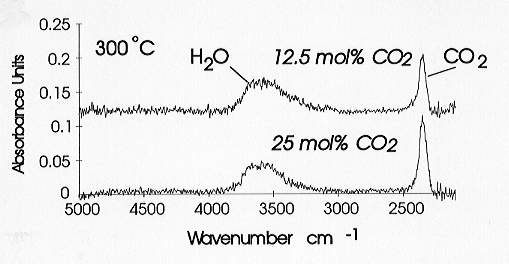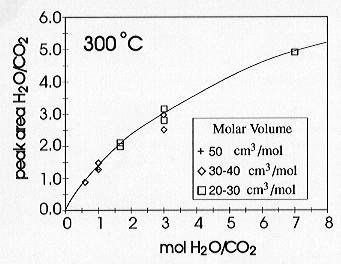

Every year several hundred papers are published that make use of fluid
inclusion data, most of which concern aqueous-carbonic fluids, yet there
is no accurate method of determining the H2O/CO2
ratios and hence the molar volumes of these inclusions. Consequently large
errors are associated with the interpretation of fluid pressure, temperature
and composition A new technique has therefore been developed to analyse
fluid inclusions in the one-phase field (above the homogenization temperature)
by FTIR spectroscopy. The technique consists of measuring the peak area
ratios of H2O and CO2 in synthetic H2O-CO2
fluid inclusions of known density and composition at a temperature in the
one phase field (Fig. 3.6-1) and thereby determining the relative extinction
coefficients for H2O and CO2. A 'calibration curve'
can then be used for the analysis of inclusions with unknown composition.
A standard gas-flow fluid inclusion stage has been modified for use with
the FTIR spectrometer by replacing the glass plates in the sample chamber
with CaF2 windows. The quartz sample containing the fluid inclusions
rests on an inconel plate with a triangular hole and is held in place by
a thermocouple. Calibration tests with critical water inclusions show that
temperature gradients are negligible and the inclusion temperature is within
2 °C of the thermocouple temperature. IR measurements were carried
out using a Bruker infrared microscope which allows focusing of the infrared
beam down to an inclusion size of less than 10 µm.
 |
Fig. 3.6-1: Representative infrared spectra of synthetic H2O-CO2 fluid inclusions with 12.5 and 25 mole % CO2 measured in-situ at 300 °C. |
The results in Fig. 3.6-2 were all obtained at 300 °C and the H2O/CO2
peak area ratios show a continuous variation with fluid composition. Density
also has a weak effect on the extinction coefficient ratio but, by combining
microthermometric and spectroscopic data it is possible to simultaneously
solve for the density and composition of an "unknown" a fluid inclusion.
The effect of additional components, such as NaCl, KCl and CH4,
on the infrared spectra and relative extinction coefficients is currently
being investigated. These experimental calibrations will allow a much more
precise determination of paleo-fluid compositions and trapping conditions
than is presently achievable. The technique developed here is not only
important as a new analytical tool for fluid inclusions but can also be
applied to high temperature spectroscopy in general, using synthetic fluid
inclusions instead of classic cells, where the control of molar volume
and composition is more difficult, and where corrosion problems at high
temperature with some fluid compositions may be encountered.
 |
Fig. 3.6-2: Calibration curve of H2O/CO2 peak area ratio at 300 °C as a function of fluid composition and molar volume. |

Tel: +49-(0) 921 55 3700 / 3766, Fax: +49-(0) 921 55 3769, E-mail: bayerisches.geoinstitut(at)uni-bayreuth.de
 Previous page
Previous page